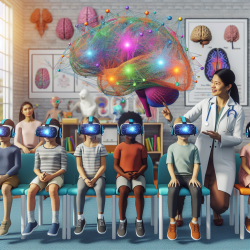Understanding Ventral Semantic Language Networks
In the realm of speech-language pathology, understanding the intricate pathways of the brain is crucial for effective therapy. The research article "Converting sounds to meaning with ventral semantic language networks: integration of interdisciplinary data on brain connectivity, direct electrical stimulation and clinical disconnection syndromes" provides a comprehensive synthesis of the ventral semantic connectivity pathways. This blog explores how practitioners can leverage these insights to enhance therapeutic outcomes for children.
The Dual-Stream Model: A Foundation for Language Processing
The dual-stream model of language processing, proposed by Hickok and Poeppel, delineates two pathways: the dorsal stream, which maps speech sounds to articulatory networks, and the ventral stream, which maps speech sounds to semantic representations. This model serves as a framework for understanding how the brain converts sounds into meaningful concepts, a process critical for language development and comprehension.
Key Findings from the Research
The research synthesizes data from various disciplines, including neuroimaging, direct electrical stimulation, and clinical studies on disconnection syndromes. It highlights the roles of four key white matter tracts in the ventral pathway: the uncinate, middle longitudinal, inferior longitudinal, and inferior fronto-occipital fasciculi. Each tract's historical evolution, anatomical features, and functional implications are discussed, providing a rich understanding of their contributions to language processing.
Clinical Implications for Speech Therapy
- Functional Mapping: Understanding the specific functions of each tract can guide the selection of intraoperative tasks during brain surgeries, minimizing neurological deficits and enhancing recovery.
- Therapeutic Strategies: Insights into how these tracts support semantic processing can inform targeted therapy approaches, such as exercises that strengthen semantic associations and improve naming abilities.
- Compensatory Mechanisms: Knowledge of potential compensatory pathways, such as the inferior fronto-occipital fasciculus compensating for uncinate fasciculus disruptions, can aid in developing adaptive therapy plans for children with brain injuries or developmental disorders.
Encouraging Further Research
While this research provides a robust framework for understanding ventral semantic networks, it also highlights areas needing further exploration. Practitioners are encouraged to engage in interdisciplinary research to validate and expand upon these findings. Collaborative efforts can lead to the development of innovative therapeutic techniques and improved diagnostic tools.
Conclusion
By integrating the insights from this research into clinical practice, speech-language pathologists can enhance their understanding of language processing and improve therapeutic outcomes for children. The ventral semantic language networks offer a promising avenue for advancing speech therapy and fostering better communication skills in young learners.
To read the original research paper, please follow this link: Converting sounds to meaning with ventral semantic language networks: integration of interdisciplinary data on brain connectivity, direct electrical stimulation and clinical disconnection syndromes.










